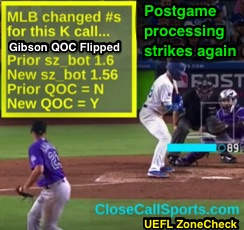CloseCallSports.com will once again provide plate scores for every HP umpire during MLB's postseason through our UEFL f/x tool, upgraded and improved for 2020 by balancing transparency, accuracy, timeliness, and thoroughness to produce the fairest accounting for ball/strike performance following each playoff game.
In 2018, we introduced UEFL f/x 1.0, a pitch tracking device that, unlike Baseball Savant StatCast, Brooks Baseball, K-Zone, and nearly every purported umpire tracker in the field, accounts for a margin of error MLB quietly admits exists and which many baseball analysts have measured.
A
full primer on UEFL f/x exists here, but in summary, UEFL f/x considers only callable pitches (ball/called strike), as measured upon arrival at the front edge of home plate, with the incorporation of a one-inch margin-of-error, pursuant to MLB's prior admission as to the technology's error. Pitches receive Quality of Correctness (QOC) designations based on boundary criteria, including Miller/Kulpa Rules (see
UEFL Rule 6-2-b-1), and are assigned a status as Correct (QOCY) or Incorrect (QOCN).
Furthermore, while most trackers, such as Boston University's famous umpire study, lazily rely on MLB/Baseball Savant StatCast's determination of whether a pitch is located inside or outside of the strike zone (with a margin-of-error of zero), and while some even deliberately deceive by failing to acknowledge that a baseball is more than just a minuscule dot (pursuant to Official Baseball Rule 3.01, its circumference is between nine and 9.25 inches), or that by rule
any portion of the ball passing through
any portion of the strike zone results in a strike (see Definition of Terms: Strike), UEFL f/x goes straight to the source—the raw data including horizontal location aka
px, vertical location aka
pz, and bottom/top of the batter's strike zone aka
sz_bot and
sz_top, respectively.
In 2019, we added two additional scores to postgame reports for the sake of transparency and fairness: ML Private (aka Zone Evaluation Equivalent Estimate) and ML Public (aka zero-error), to accompany the existing UEFL f/x figure.
For example, Mike Estabrook's plate on September 26, 2020 (Milwakee/St Louis) is pictured as a product of UEFL f/x 3.0, featuring three scores: ML Private's 98.3%, UEFL f/x's 97.5%, and ML Public's 95.0%.
When we discussed the player-umpire disconnect on balls/strikes and, namely, how MLB's public-facing technology (
ML Public) portrayed umpires as, on average,
91% accurate behind home plate while MLB, behind the scenes (
ML Private) told umpires they were actually
97% accurate, this is precisely what the three-score report was meant to address.
Accordingly, a wholly average triple-score would read as ML Public: 91%, UEFL f/x: 94%, ML Private: 97%.
For 2020, we've taken it a step further. Over the past year, we've observed a huge flaw with real-time strike zone graphics called post-game processing. Succinctly, during a game, in real-time, MLB through its PitchCast application (branded by ESPN as K-Zone, by FOX as FoxTrax, etc.) feeds broadcasters as well as its own Gameday application (MLB dot com) px, pz, sz_bot, and sz_top variables based on placeholder strike zones for batters.
In other words, one incredibly significant reason MLB cannot afford to try real-game RoboUmp experiments at present is because RoboUmp simply cannot accurately adjust to individual batter heights and stances, and thus, zone heights sz_bot and sz_top...thus MLB feeds placeholder values which may or may not be accurate.
This is why during a game it may look like an umpire has missed a call while hours after a game, if one were to follow up, it would appear that the umpire made the correct call: this usually has the effect of improving the umpire's plate score.
We've observed this effect during ejections: The player or coach sees what appears to be an incorrect call upon watching a replay in the dugout-adjacent video room, ventures out to argue the call, and gets ejected. Broadcast shows the replay purporting to indicate an incorrect ball/strike call, and fans are left believing the umpire has erred. Hours later—after all attention regarding the pitch has shifted and the placeholder real-time strike zone box accepted as the real deal—MLB quietly goes back to the game data and changes sz_bot and sz_top.
In this linked 2019 example, Dave Roberts argues a strike call by Greg Gibson at the batter's hollow-of-the-knee, only the computerized box, in real-time, indicated the pitch was located beneath the strike zone. Gibson ejects Roberts, replays ad nauseam convince Los Angeles the call was wrong. Hours after the game, MLB changes sz_bot to a value that has the consequence of changing Gibson's UEFL f/x Quality of Correctness from Incorrect to Correct. Similar stories exist for ejections by Ron Kulpa (Houston), Ramon De Jesus (Minnesota) and Jeremie Rehak (Anaheim).
For this reason, in 2020, we will report two sets of three-scores ML Private, UEFL f/x, and ML Public. On the night of every game, we will report preliminary/unprocessed scores and on the day after, we will report final scores. This should effectively illustrate pre-processing error, real-time computer vertical blind spot error, inflexible robot error, Altuve is shorter than Judge error, or whatever other label you wish to assign.
The compulsion, naturally, is to run with the first numbers that exist—the preliminary/unprocessed scores proven to routinely and consistently undervalue umpire accuracy figures—yet these are the same figures that the baseball world presents as static fact, and final. Our goal, is through follow-up reporting of final scores, is to illustrate baseball's unspoken zone problem relative to vertical ball/strike calls, and how this known piece of persistent real-time inaccuracy influences and impacts perceptions of umpire plate performance.



























